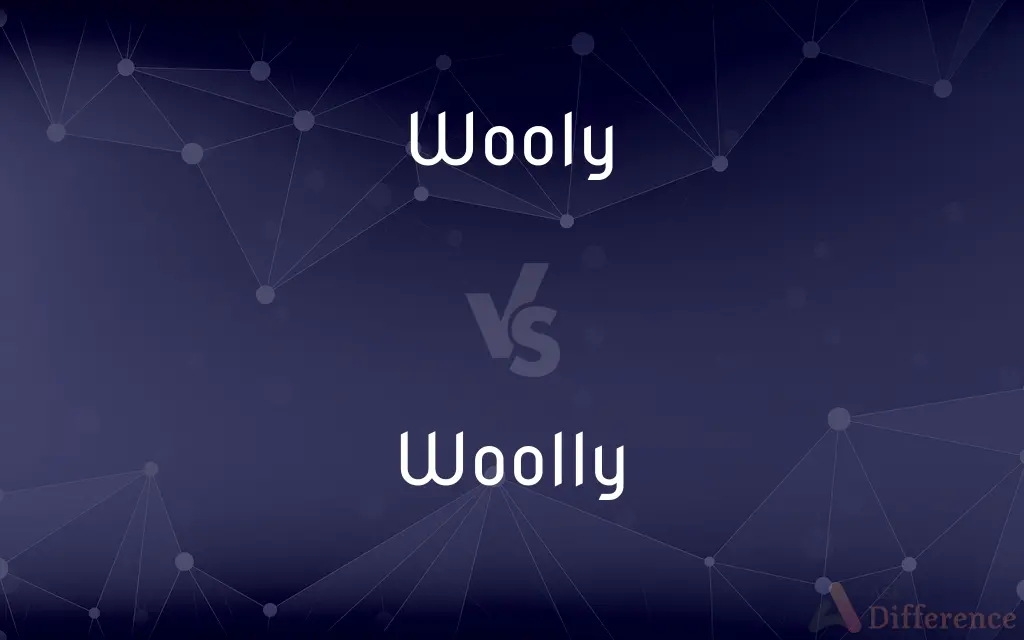Wooly vs. Woolly — What's the Difference?
By Maham Liaqat & Fiza Rafique — Updated on March 6, 2024
Wooly is a less common spelling variant of woolly, both describing something resembling wool in texture or covered in wool.

Difference Between Wooly and Woolly
Table of Contents
ADVERTISEMENT
Key Differences
Wooly and woolly are adjectives used to describe objects or animals that are covered in wool or have a texture resembling wool. The primary difference between the two is in their spelling, with woolly being the more commonly accepted form in most English-speaking countries. This form captures the essence of being like wool, in texture, appearance, or in being covered with wool.
Woolly is often used to describe animals, especially sheep, that have a thick, soft coat of wool. It can also refer to materials, clothing, or other items that have a similar texture to wool or are made from wool. Wooly, while conveying the same meaning, is a variant that may appear in different contexts or regions, but it's less frequently used in formal writing.
When discussing the character of materials or clothing, woolly suggests a soft, warm, and often fluffy quality, ideal for insulation against cold. Wooly, on the other hand, conveys a similar sense of warmth and texture but may be seen as a less conventional spelling in some contexts.
In literary or figurative language, woolly can also describe something vague, confused, or not clearly thought out, such as "woolly thinking." The variant wooly can be used in the same way but might be encountered less often in this context.
Choosing between wooly and woolly often depends on the preferred spelling convention of the writer or publication. Woolly is the spelling recommended by most dictionaries and style guides, reflecting its status as the more standard form.
ADVERTISEMENT
Comparison Chart
Spelling
Less common variant
More commonly accepted spelling
Definition
Describing something resembling wool or covered in wool
Same as wooly
Usage Frequency
Less frequent in formal writing
Preferred in most English-speaking countries
Context
Can be used interchangeably with woolly
Used to describe wool-like texture or appearance
Formality
Seen as less conventional
Recommended by dictionaries and style guides
Compare with Definitions
Wooly
Less commonly used spelling.
He preferred the wooly spelling in his writing.
Woolly
Having a texture like wool.
The woolly sweater kept him warm.
Wooly
Resembling wool in texture.
The wooly fabric was perfect for winter wear.
Woolly
Commonly accepted spelling.
Most editors insist on the woolly spelling.
Wooly
Covered in wool.
The wooly lamb hid under its mother.
Woolly
Standard form.
The word woolly is found in most spell-checkers.
Wooly
Can indicate confusion in thought.
Her explanation was a bit wooly.
Woolly
Describes vague or unclear thinking.
His woolly arguments were hard to follow.
Wooly
Variant form.
Some dictionaries list wooly as an alternative.
Woolly
Covered with wool.
Woolly mammoths once roamed these lands.
Woolly
Made of wool.
Put on a woolly jumper and turn down the thermostat.
Woolly
Relating to, consisting of, or covered with wool.
Common Curiosities
What's the difference between wooly and woolly?
The difference lies primarily in spelling; "woolly" is the more commonly accepted form.
Does wooly appear in formal writing?
It's less common in formal writing, with "woolly" being the standard spelling.
Can wooly/woolly describe things other than texture?
Yes, both can describe vague or confused thinking, though "woolly" is more frequently used in this context.
How do I know which spelling to use?
Use "woolly" for formal writing or following most English spelling conventions.
Is one spelling more correct than the other?
While both are correct, "woolly" is the preferred spelling in most contexts.
Do both spellings appear in English dictionaries?
Yes, both spellings can be found, but "woolly" is often listed as the primary form.
Can wooly and woolly be used interchangeably?
Yes, they can be used interchangeably as they refer to the same qualities or characteristics.
Why is woolly the preferred spelling?
"Woolly" is preferred by most dictionaries and style guides due to standard spelling conventions.
How does the spelling impact the meaning?
The spelling does not impact the meaning; the difference is purely orthographic.
Can the spelling vary by English dialects?
Yes, spelling preferences can vary, but "woolly" is widely accepted across most dialects.
Is the choice of spelling important in academic writing?
Yes, in academic writing, it's important to use the more widely accepted "woolly."
Has the preference for one spelling changed over time?
Preferences can evolve, but "woolly" has consistently been the more standard choice.
Can the choice of spelling reflect the writer's region?
It might, although "woolly" is generally preferred regardless of region.
Why do some people use the less common spelling?
Personal preference, regional influences, or unawareness of the standard convention may lead to the use of "wooly."
Are there any rules for when to use wooly vs. woolly?
The main rule is based on spelling preference, with "woolly" being more standard.
Share Your Discovery

Previous Comparison
Integral vs. Integer
Next Comparison
Coxswain vs. SteersmanAuthor Spotlight
Written by
Maham LiaqatCo-written by
Fiza RafiqueFiza Rafique is a skilled content writer at AskDifference.com, where she meticulously refines and enhances written pieces. Drawing from her vast editorial expertise, Fiza ensures clarity, accuracy, and precision in every article. Passionate about language, she continually seeks to elevate the quality of content for readers worldwide.
















































